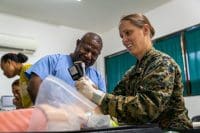Collaboration improves outcomes.
Mrs. C, an 81-year-old widow with a history of chronic obstructive pulmonary disease, hypertension, and diabetes, is admitted to the hospital with pneumonia. This active and independent woman is a vibrant part of her community. During her hospital stay, she’s alert, oriented, and pleasant to her caregivers. Her treatment includes antibiotics and steroids. Her fever quickly resolves, her cough decreases, and her lungs sound clear. Mrs. C’s daughter, who lives several hundred miles away, calls every evening and Mrs. C’s neighbor takes her home after 3 days of hospitalization.
Mrs. C has two new prescriptions and a dosage change in her blood pressure medication. At discharge, prescriptions are sent electronically to the pharmacy, and Mrs. C is given discharge instructions and told to see her primary care provider within 3 to 5 days.
Mrs. C’s neighbor isn’t able to stop at the pharmacy to pick up Mrs. C’s prescriptions and Mrs. C is so tired from lack of sleep during her hospitalization that she doesn’t go to the pharmacy for two days. She has little food in the house and has no energy to prepare meals, so she doesn’t eat much. In addition, she forgets to make a follow-up appointment with her provider. When she picks up her new medications, she doesn’t understand the directions for the prednisone taper and doesn’t remember to decrease her blood pressure medication dose.
As a result, Mrs. C becomes dehydrated, hypotensive, and develops acute renal failure. On her fourth day at home she falls and breaks her hip. She requires another hospitalization and a prolonged inpatient rehabilitation stay.
Could this have been prevented? Would your discharge plan or interventions change if you could see what happens when patients go home?
Re-admissions
Nearly one-fifth of Medicare patients are readmitted to the hospital within 30 days of a first admission. Many factors—physiologic, patient, clinical, and systems—influence unplanned readmissions and frequently have little to do with the initial diagnosis.
Many hospitalized patients are so eager to go home that they don’t share facts that might delay discharge, and they overestimate their abilities and minimize ongoing symptoms. Some patients are hesitant to admit they don’t understand their diagnosis or complicated treatment plan, they’re overwhelmed and intimidated, and they just want to be home.
According to Krumholz, physiological stressors that occur during an acute hospitalization may result in post-hospitalization syndrome (sleep deprivation, delirium, physical deconditioning, nutritional issues, and dehydration), which temporarily affects recovery. This consequence of hospitalization may go unrecognized by the patient, family, and providers. In Mrs. C’s case, a transitional care nurse (TCN) referral for a home visit the next day might have identified and ameliorated the issues that led to her rehospitalization.
Problem identified
Seven years ago, the inpatient clinical nurse specialist (CNS) team at Southwestern Vermont Medical Center (which has received Magnet® recognition five times) was seeing many patients like Mrs. C. who were being discharged home but didn’t meet the criteria for post-acute care services and then were readmitted. One explanation was a lack of post-hospital resources. At the time, small hospitals in rural communities across the country were experiencing a decline in inpatient census and moving toward more outpatient-based care. Fortunately, Southwestern Vermont Medical Center had six unit-based CNSs, but as inpatient census continued to decline, it was clear that this wasn’t sustainable. To avoid losing these valuable resources, the chief nursing officer and other nurse leaders supported the CNSs in creatively reinventing their roles.
The masters-prepared CNSs, who would serve as TCNs, chose to implement the Mary Naylor Transitional Care Model modified for their rural community. (See Transitional Care Model.)
Transitional Care Model
The Transitional Care Model has nine components:
- Screening for adults at high risk for poor outcomes in the transition from hospital to home
- Staffing with advanced-practice RNs who take primary responsibility for managing care
- Maintaining relationships with patients and families to establish trust
- Engaging patients and caregivers in the design and implementation of care plans
- Assessing and managing risks and symptoms
- Educating patients and families and promoting self-management
- Collaborating to establish agreement on care plans
- Promoting continuity to avoid breakdowns in care after a patient transitions to home
- Fostering coordination to ensure communication between providers within the healthcare organization and those who are community-based.
The CNSs, each with over 30 years of clinical experience in the acute care setting, had strong clinical expertise and communication skills and had been a part of the organization for decades.
Program designed
In this community, patients have strong relationships with their primary care providers and the transitional care program was designed to support those relationships. TCNs partnered with local providers to build open communication with them and their office staff, who, in turn, provided the TCNs with direct access to electronic health records so they can view up-to-date information about medication changes, appointments, and office visit notes.
Criteria for admission to the transitional care program include:
- chronic disease/high-risk health issues with a potential and desire for improvement
- no diagnosis (such as an active psychiatric disorder) that interferes with self-management potential
- ability to meet goals within a 12-week timeframe
- ability to understand discharge plans and medication regimens
- consent to participate in the program.
The service is free, and it can include just one home visit or can last for up to 3 months. The TCNs determine who meets criteria and accepts referrals from any caregiver. Early in the program, most referrals came through hospital interdisciplinary rounds when it was determined a patient didn’t meet criteria for current home healthcare. As the program matured, the referral base expanded to include primary and specialty providers for patients who haven’t been hospitalized but are high risk.
Each TCN partners with four primary care practices to follow adult patients who meet the program criteria. As patients transition through the healthcare system, the TCN supports the patient and family by providing self-management education, advocating for needed resources, collaborating with members of the care team across settings, guiding patients through the complex healthcare system, and facilitating communication with the provider and community healthcare partners.
Patients in the transitional care program have the advantage of continued high-level follow-up for clinical oversight and chronic disease education. The program also provides patients with a consistent person they know and learn to trust to guide them through the complexities of a difficult illness in a complicated healthcare system. In addition, the healthcare system benefits from a team of CNSs who are skilled at identifying need, coordinating care, and filling gaps.
TCN role defined
The salaried TCNs function interdependently at the highest level of their license. They attend daily hospital interdisciplinary rounds to identify patients who meet program criteria and have no other resources after discharge. Each TCN typically cares for 20 to 30 patients. They see patients at home within 24 to 48 hours after discharge. Because TCNs are the only clinicians who see patients wherever they are no matter the setting, they have access to the full range of patient needs and barriers and can facilitate communication across settings.
Initially, home visits are weekly (or more frequently if needed). Over time, visits are decreased to bimonthly or monthly and eventually become phone visits. Information gleaned at each visit is documented in a template visible to inpatient and outpatient providers. The initial home visit is an hour or longer. If the patient has been in the hospital, the TCN spends significant time at the first visit determining the patient’s understanding of their diagnosis, discharge instructions, and medications.
At each visit, the TCN works with the patient to establish and re-establish goals and identify barriers the patient might be encountering. Developing strong nurse-patient relationships and uncovering social barriers are key to helping patients achieve successful outcomes.
Outcomes achieved
The transitional care program is an integral part of this community healthcare system, expanding to reach people who traditionally slipped through the cracks. The program has drawn together independent community resources for a cohesive and common goal, working together to ensure efforts aren’t duplicated and needs aren’t missed. (See A growing team.)
A growing team
Early in the transitional care program, the transitional care nurses identified the role that social determinants of health (poverty, low health literacy, food insecurity, and social isolation) play as patients transition from hospital to home. To address these needs, a half-time social worker was transferred from the inpatient setting to the team.
As further gaps were identified, the team continued to grow. It now includes diabetes educators, a palliative care nurse, and pharmacists. In addition, community care teams were established for high-risk adults and children. Most team members were added via a budget-neutral mechanism or grant allocation. Over time, as the program data demonstrated success, grant-funded team members transitioned to permanent additions.
In the 7 years since the transitional care program was launched, nearly 2,000 patients have participated with excellent outcomes. Inpatient readmission rates for patients enrolled in the program have dropped by 50%, and emergency visits have dropped by 15%. Projected cost savings are estimated to be close to $1.5 million per year. Patient satisfaction rates are consistently high in the categories of increased confidence in disease and medication self-management skills. Several common themes offered in patient survey responses include feeling more cared for by the healthcare system, identifying care as less fragmented and more coordinated, and valuing the consistency of having the same TCN provide care over time.
The CNS who serves as a TCN provides the benefit of education and expanded skills, but RNs can also be taught to serve in this role. And as the transition from fee-for-service to value-based payment continues, transitional care will continue to show value by reducing readmissions. This transitional care model fits well within a small rural hospital structure, but large organizations in urban areas may need to find a different implementation design better suited to their needs.
A different outcome for Mrs. C.
When the TCN visits Mrs. C. within 24 hours after discharge, she notes that the patient hasn’t picked up her prescriptions and doesn’t have the food she needs for easy meal preparation. Working in partnership with Mrs. C’s provider, the TCN helps the patient access the resources she needs and provides medication education. Mrs. C recovers uneventfully at home.
Barbara Richardson and Karen Coppin are transitional care nurses at Southwestern Vermont Medical Center in Bennington.
References
Bailey MK, Weiss AJ, Barrett ML, et al. Characteristics of 30-day all-cause hospital readmissions, 2010-2016. Agency for Healthcare Research and Quality. February 2019. hcup-us.ahrq.gov/reports/statbriefs/sb248-Hospital-Readmissions-2010-2016.jsp
Cross KL, Johnson P, Allard BL, Shuman CJ. Clinical nurse specialists’ perceptions of transitioning into a rural community-based transitional care role. J Nurs Adm. 2020;50(9):456-61. doi:10.1097/NNA.0000000000000916
Jencks SF, Williams MV, Coleman EA. Rehospitalizations among patients in the Medicare fee-for-service program. N Engl J Med. 2009;360(14):1418-28. doi:10.1056/NEJMsa0803563
Krumholz HM. Post-hospital syndrome—An acquired, transient condition of generalized risk. N Engl J Med. 2013;368(2):100-2. doi:10.1056/NEJMp1212324
Mayo AM, Ray MM, Chamblee TB, et al. The advanced practice clinical nurse specialist. Nurs Adm Q. 2017;41(1):70-6. doi:10.1097/NAQ.0000000000000201
Naylor MD, Brooten DA, Campbell RL, et al. Transitional care of older adults hospitalized with heart failure: A randomized, controlled trial. J Am Geriatr Soc. 2004;52(5):675-84. doi:10.1111/j.1532-5415.2004.52202.x


















